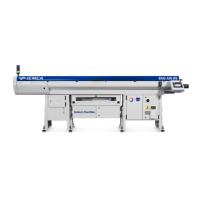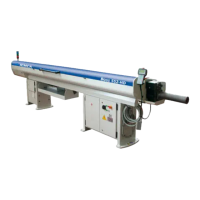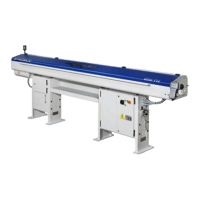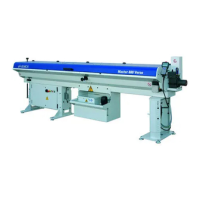Do you have a question about the IEMCA BOSS 332-545-551 E and is the answer not in the manual?
Details warranty validity, installation requirements, and submission of documents.
Explains the manual's intent, safety symbols, and related documentation.
Lists identification details like manufacturer, CE marking, model, and serial number.
Advises to contact Technical Assistance Centres for necessary support.
Lists supplementary manuals like push-button panel and wiring diagrams.
Provides an overview of the BOSS automatic bar feeder and its applications.
Explains the step-by-step sequence of the bar feeder's automatic operation.
Details various safety features like emergency buttons and interlocked guards.
Describes safety labels and their meanings on the machine.
Outlines different models and their maximum bar length and extension capabilities.
Presents overall dimensions and general technical data for different models.
Introduces optional devices to enhance feeder performance and versatility.
Introduces special devices for coupling the feeder with sliding headstock lathes.
Introduces special devices for coupling the feeder with cam lathes.
Emphasizes reading the manual, following instructions, and not tampering with safety devices.
Covers safe handling, lifting, positioning, and electrical connection procedures.
Outlines safety precautions during adjustments and parameter changes.
Details safety measures during normal operation, including PPE and clearing the workspace.
Provides safety guidelines for maintenance, lubrication, and spare parts.
Describes the three possible packaging methods for the bar feeder.
Provides critical warnings and instructions for safe lifting operations.
Specifies requirements for the installation site, including stability, ventilation, and dimensions.
Details the installation steps for feeders without the axial displacement feature.
Details the installation steps for feeders equipped with an axial displacement device.
Explains the installation of devices for coupling with sliding headstock lathes.
Explains the installation of devices for coupling with cam lathes.
Guides on how to correctly fill the lubricating oil tank.
Provides essential safety warnings and instructions for electrical connections.
Details the procedure for connecting pneumatic systems and setting air pressure.
Refers to the push-button panel manual for software configuration.
Introduces adjustments needed for operation based on bar size and machining type.
Covers common adjustments like feeding chain tension and pressure switch setting.
Details how to set up the feeder based on new bar diameters.
Explains the timing procedure for cams and microswitches in cam box systems.
Explains the function of the main controls and their behavior in different modes.
Details the functions of each key on the hand-held keyboard.
Explains the meaning of different colored and blinking lights on the indicator.
Provides guidance on bar preparation, including length and straightness.
Outlines the sequence for initial feeder setup and starting the automatic cycle.
Describes procedures for emergency stops and normal machine shutdown.
Explains how to restart automatic cycle after manual interventions.
Details how to resume operations after a power interruption.
Provides a quick guide for changing machining types with or without guide changes.
Emphasizes safety during maintenance and proper cleaning methods.
Presents a table outlining maintenance tasks and their recommended frequencies.
Details how to check the condition of the revolving tip and collet.
Guides on checking and topping up the lubricating oil level.
Provides instructions for draining and refilling the lubricating oil.
Describes the greasing procedure for the guide opening screw.
Details how to check the air filter unit for condensate and adjust pressure.
Explains how to use and disconnect the axial displacement device for maintenance.
Lists common faults like non-starting, no response, or sudden stops with causes and cures.
Addresses issues related to bar insertion and dropping into the magazine.
Covers problems with bar insertion into the lathe collet.
Details issues during bar feeding into the lathe spindle or collet.
States that feed chain replacement is complex and requires IEMCA after-sales service.
Provides step-by-step instructions for replacing the guide opening belt.
Details how to replace the keyboard battery and safety warnings.
Explains how to replace the PLC battery and the importance of timely replacement.
Lists original spare parts recommended for a two-year period of normal use.
States that dismantling should be done by specialized workers following safety laws.
Provides contact information for IEMCA service centers worldwide.
| Brand | IEMCA |
|---|---|
| Model | BOSS 332-545-551 E |
| Category | Industrial Equipment |
| Language | English |




